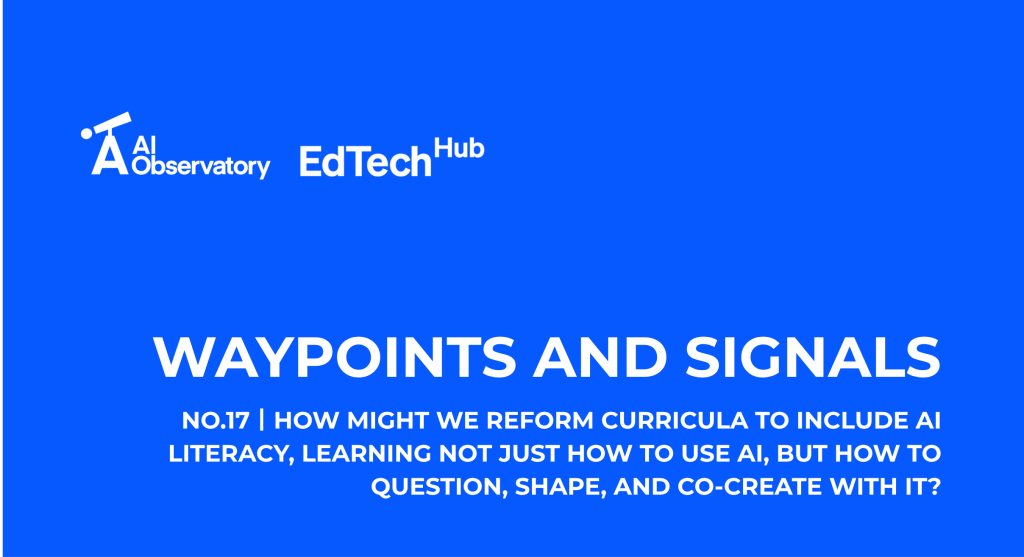How might we reform curricula to include AI literacy, learning not just how to use AI, but how to question, shape, and co-create with it?

One challenge in education today is: generic AI skills for learners are increasingly seen as essential, but they are not enough on their own (WEF, 2025). Interventions that focus narrowly on technical know-how (Sperling et al., 2025; Deriba & Sanusi, 2025) risk reducing AI literacy to a tick-box exercise and deepening the gap between students who merely use AI and those equipped to shape it.
Each week we are spotlighting a section of the framework, showing how the waypoints and signals insights inform it, so that we can share progress and invite reflection on its development. This week we’re charting how reforming curricula may enable Learners for AI Literacy.

Early signals
Setting reference points for holistic AI literacy
With definitions of “AI literacy” still contested (Sperling et al., 2025), global frameworks are emerging to guide curriculum design. They extend focus from teaching learners how to use AI toward equipping them with skills to critique, question, and reshape it.
Global – UNESCO AI Competency Framework for Students: Provides a global reference for integrating AI into curricula, combining technical knowledge with social, ethical, and critical dimensions to equip learners as responsible citizens with the capacity to question and shape AI systems. (UNESCO, 2024)
Global – The AILit Draft Framework: A joint initiative of the European Commission and OECD, supported by Code.org and experts. It sets out pathways for students to gain technical skills while also interrogating, critiquing, and creatively engaging with AI. The draft is open for global feedback, inviting stakeholders to help shape a framework for diverse educational needs worldwide. (AILit Framework)
Co-designing more comprehensive curricula, with teachers
Teachers’ perspectives are valuable for curriculum development, as they draw on close knowledge of their students and are ultimately the end-users of curriculum materials (Yau et. al, 2023). We’re seeing educators being invited to actively shape AI literacy curricula.
Colombia – National Day of AI: Colombia will host its first National Day of AI this week, with thousands of educators expected to participate as a step toward building nationwide AI literacy. The accompanying three-lesson unit was co-designed with Colombian teachers to reflect diverse classrooms and give educators flexibility to adapt it to their students. (Day of AI, 2025)
China – Collaborative construction of AI curricula: In an experimental primary school programme, teachers were treated as co-designers, while students acted as evaluators whose feedback reassured teachers and guided AI curriculum development. The study argues that valuing teachers’ voices can help policymakers build trust, secure teachers’ commitment, and sustain curriculum reform. (Wang et al., 2024)
Building educator capacity to teach AI literacy
Teacher training is seen as a critical foundation for growing the AI literacy of learners (UNESCO, 2022). While curriculum reform sometimes outpaces teacher capacity (Fundi et. al, 2025), we’re seeing a push to equip teachers with the capacity to deliver AI literacy.
India – SOAR initiative: Alongside introducing AI literacy for students in Classes 6–12, India has developed a 45-hour professional module, “AI for Educators.” The programme aims to equip teachers with the competencies to guide AI learning journeys – recognising that the literacy of students depends on the literacy of their teachers. (Government of India, 2025).
UAE – National AI curriculum: Prior to rolling out its national AI curriculum, the UAE reportedly undertook a “gap analysis” to evaluate readiness and address knowledge gaps through targeted training programmes. Conducting such an analysis aligns with one of UNESCO’s 13 recommendations for effective AI curriculum provision. (Middle East AI News, 2025; UNESCO, 2022).
Reflections:
- As AI integration in education is increasingly commonplace, AI literacy among learners and educators will be crucial to making sure these tools are used effectively, and in ways that promote equity and holistic learning.
- Ministries of Education, implementing organisations, and others considering AI literacy do not need to start from scratch: there are existing frameworks which could provide guidance on how to structure AI literacy campaigns.
- Local co-creation and buy-in are still a best practice: consulting those targeted by AI literacy efforts in what they learn and how they learn it will only improve their potential for success.
Swipe for a quick take 👇🏽
We’d love to hear from you! What’s been shaping your thinking on AI? Drop your thoughts (and reading recommendations) in the comments. Explore more from EdTech Hub’s AI Observatory.
EdTech Hub’s AI Observatory is made possible with the support of the UK’s Foreign, Commonwealth and Development Office.











